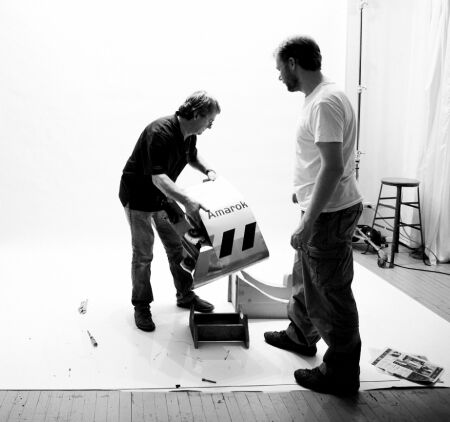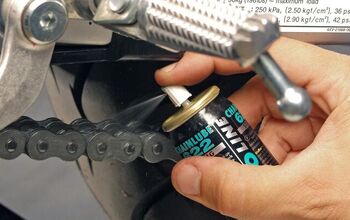Canada's First Electric Superbike: Amarok Racing P1 - Motorcycle.com
In talking with motorcycle designer Michael Uhlarik about his P1 – Canada’s first electric superbike – one perceives an understated demeanor belying a competitive intensity as he anticipates the TTXGP racer’s debut June 17-18 at Loudon, N.H.
But perhaps this should be expected. The 36-year-old president of Amarok Consultants, a motorcycle product planning and design company in Lennoxville, Quebec – along with his business partner Kevin O’Neil – said he spent the last two years and enough money to “make my wife nervous” putting the innovative machine together.
Amarok Electric Motorcycle Racing’s 325-lb, 75-plus-hp machine boasts a power-to-weight ratio and dimensions approaching those of a Yamaha TZ250R Two-Stroke GP bike, after which it was modeled.
This year, the TTXGP has two classes – Open Formula TTXGP, and TTX75 for lower-budgeted teams with a maximum battery power of 7.5 kWh and maximum weight of 250 kg (551 lbs).
Uhlarik and O’Neill’s P1 will compete in this latter class with the highest allowable power, but at 148 kg (325 lbs) it beats the weight limit by a massive 103 kg (227 lbs).
“We intend to race in F75, but expect to be competitive with many of the open class by year’s end,” Uhlarik said, “Our goal is to lap any track on par with our benchmark, a Yamaha TZ250R.”
And they are actually working with a very modest budget, Uhlarik said. Their 11 person race team is helping mostly without pay – but with opportunity to be in on Canada’s contribution to electric motorcycle racing.
To augment the likelihood of Uhlarik’s goal, a second-generation version, the P2, should be ready by the end of the year. It will shed another 50 lbs (23 kg) in order to deliver performance on par with Yamaha’s classic 250cc premix-powered racer.
At least this is the plan. Uhlarik, a native Canadian who spent 11 years in Europe designing Japanese, Italian and Asian OEM motorcycles and components, won’t divulge many P1 specifications, but did share a few details.
Unlike many converted sportbikes – which Uhlarik considers fraught with compromise – the purpose-made bike’s batteries are centered on its roll axis. This should help make the P1 a spectacularly flickable machine.
“The entire electrical powertrain is in the middle where it should be. You know ‘mass centralization’ is a term we hear a lot, and for good reason,” Uhlarik said, “The battery is contained within the fuselage within the aluminum monocoque. There are no wires hanging out; you can’t see any of the electrical system. It’s all contained. It’s all water tight, it’s all thermally controlled. It’s an integrated system.”
The clean-sheet creation follows a proprietary Concentric Design philosophy, which Uhlarik explained:
“It is an adaptation of the aerospace industry approach of first defining a mission, then setting specification afterwards, in a stepped pyramid of importance, where each layer is subordinate to the one directly above it,” Uhlarik said. “This method eliminates individual or personal prejudices, by forcing a scientifically defined parameter as the absolute authority in design decision making.”
Does it sound like he means business? He continued:
“It takes a long time to explain this properly, but the output is roughly this: A motorcycle is not a frame, engine and suspension, it is a harmonized vehicle system that must also include difficult-to-fix variables such as terrain, weather, and mostly the skill, size and mentality of the rider,” Uhlarik said, “To get the most out of a vehicle system's potential, all of these must be understood in the context of one mission, and ranked accordingly.”
As such, the P1 uses proven, twin air-cooled Agni 95 motors, high-quality 7.5 kWh lithium polymer batteries and battery management system.
While he drafted the architecture, the electric racer was fabricated in collaboration with O’Neil, who has been a motorcycle mechanic and racecar builder for 35 years.
“During the process Kevin was instrumental in saying, ‘Well hang on a minute, what if we try this,’ or ‘I have an idea for this coupling,’” Uhlarik said, “Especially when it came to the mechanics of the drivetrain. He almost singlehandedly took over engine couplings, engine supports and a great deal of the rear suspension.”
The chassis utilizes an alloy steel swingarm and Hossak-type front end, which Uhlarik said is deceptively rigid. Its loads are distributed into the alloy fuselage to save weight compared to an overbuilt traditional frame.
“The fork wants to rip the headpipe off of a motorcycle every time you are under braking,” Uhlarik said of a traditional telescopic fork which requires a sturdy frame to compensate. “It acts like lever.”
Front and rear brakes were stated only as by Nissin (not Tokico as pictured), and wheels are by Marchesini. We were denied geometry specs, but since the P1 is modeled on the TZ250R, that’s at least a hint. A 2003 TZ250R had a wheelbase of 1342mm (52.83 inches), castor of 22 degrees, trail of 82mm, but these may not be accurate indicators.
“Complete geometry will not be disclosed. I have never understood why our competitors publish this sort of information, as it tells any professional in the business exactly what design solutions (and problems) are inherent in the vehicle system,” Uhlarik said. “You will never find geometry info on current factory MotoGP bikes for that reason. Feel free to speculate. All I will say is that the true dimensions will surprise many people.”
Frankly, we respect this attitude, and it helps underscore Uhlarik’s credentials.
Prior to establishing Amarok Consultants a couple years ago, he owned Type U Motorcycle Design, a six-person motorcycle design consultancy studio in Barcelona, Spain. Before that, he worked five years for the large industrial design firm GK/Yamaha.
During his years in Europe, he designed motorcycles and sub-assemblies for the Piaggio Group’s various brands, Yamaha, Chinese and Indian OEMs. He even had a hand in designing the 2002 Yamaha YZR-M1 MotoGP racer’s fairing when Carlos Checa was the team’s top rider.
In 2008, back home in Canada, he was project leader for advanced concepts for Bombardier. In addition to his motorcycle consultancy, also writes a column for Cycle Canada, started his own publication, and teaches industrial design at the University of Montreal and Ontario College of Art and Design.
His students are keen on electric transportation, Uhlarik said, and he wanted to put his name on designs before the electric motorcycle industry goes mainstream, and major OEMs come in and take over.
He also wants to demonstrate what can be done without sophisticated equipment, a massive budget, and his first effort looks like it might very well succeed.
As you may know, Yamaha’s quarter-liter two-stroke can give even a well-ridden four-stroke literbike fits on a racetrack. It compensates for less power with feathery weight which yields superior braking, cornering, drive out of the corners, and only marginally less acceleration on the straights.
If Amarok Racing can get the P1 and ultimately the P2 to perform like the Yamaha, race fans will likely witness some David vs. Goliath battles.
The P1’s lean angle is also undisclosed, but is, “extreme, and better than that of an R6,” Uhlarik said.
Everyone wants more in some sense of the word, but for Uhlarik, “less is more,” he said.
“There are actually many ways to achieve the same goal,” Uhlarik said, “But you know, more power – our American competitors are all chasing more power.”
But Japanese and European influences shaped his thinking, he said, as did visionary designers such as Lotus Cars founder, Colin Chapman, aeronautical pioneer Jack Northrop, and several others.
“One-hundred-eighty horsepower out of an electric engine (motor) is not the same [as for a gas engine]. An electric motorcycle generates maximum torque at 0 rpm. It would be like having a bike in its powerband at all times,” Uhlarik said, “The great limitation is traction. And that’s why with all these bikes at the high end – since we’ve gone completely mental and 180 is the new 100 hp – you have to have these big, sophisticated traction control systems. The limitation is the tire, the limitation is the contact area.”
Uhlarik said his bike will scream with a new kind of high-performance aural signature, weigh less than half of many competitors’ bikes, and deliver more than half the power.
“The reality is, you know, my philosophy is, if the bike weighs 124 kg, or 275 lbs, and has 80 or 90 hp, it will have a power-to-weight ratio of 650-700 hp per ton.” Uhlarik said. “That’s more than Michael Czysz’ bike last year, and more importantly, you can put that kind of power into the track at all times. When you’ve got 200 electric horsepower, you’re shredding the tires; constantly going to be slipping.”
He said the team is still negotiating with riders – its top pick is un-named at present, but reportedly a fast, young AMA superbike racer. So far, Amarok Racing has done some testing but nothing head-to-head.
“To be honest, where we are in our test schedule, that’s not interesting to us. What we’re trying to do is build a reliable system – something that we know will deliver as expected when we show up at New Hampshire, and then we’ll see,” he said, “I’m very realistic. It sounds like I’m downplaying – it’s because I am. I’m not going to go out there saying: ‘We’re the world’s this! And the best that! And groundbreaking!’ No we’re what we are, and I’ll let my bike do my talking for me.”
Amarok Electric Motorcycle Racing is seeking more sponsors. It is currently supported by Pro6 Cycle, Canada’s largest track day operator, Dunlop Tires, i am, Uhlarik’s publication, MotorcycleMarketWatch.com, and his company, Amarok Consultants.
Related Reading
Amarok P1 Electric Racing Motorcycle: Less is More, says Designer
First U.S. TTXGP at Infineon Raceway
2010 FIM e-Power race at Laguna Seca
2010 FIM e-Power race at Laguna Seca
Electric Sportbike Reaches 190.6 mph
2011 Brammo Empulse Preview
TTXGP announces July race at Portland Int’l Raceway
More by Jeff Cobb





































Comments
Join the conversation